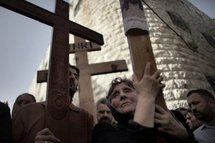
Eastern European Orthodox Christians walk the Via Dolorosa in Jerusalem's Old City during a Good Friday procession. (AFP/Marco Longari)
As part of the Good Friday ceremonies, the faithful descend onto the Old City to walk the Via Dolorosa, or Way of Suffering, the route tradition says Jesus carried the cross on which he was to be crucified by the Romans.
The procession begins at the Monastery of Flagellation, where Jesus was beaten, mocked and crowned with thorns.
It follows the narrow often climbing street and the 14 stations of the cross along its way, including where Jesus met his mother, fell several times, was helped in carrying the cross, and met the lamenting women of Jerusalem.
The procession ends at the Church of the Holy Sepulchre, built over the sites where Christians believe Christ was crucified and buried.
As bells tolled across the city, black-robed priests and nuns mingled with pilgrims and tourists. Many carried crosses while some, including a group from California smeared in fake blood, re-enacted the crucifixion.
Many of the pilgrims were unable to enter the church due to the huge numbers of faithful gathered inside and outside as well as the heavy security.
This year, numbers were greater than usual with Catholics and other Christians in the West celebrating Easter on the same day as Orthodox Christians, a rare overlap.
As a result the procession, which included a large Russian contingent, was noisy and at times unruly.
Carrying wooden crosses of all sizes, the pilgrims were ushered by police as they trampled patiently, often becoming bottlenecked at points in the narrow alley ways.
Nur Bishay, a Coptic Christian from Cairo, lamented that "the silence of prayer and sacred chants were drowned out by the police, the shouting and the chaos."
The procession was further interrupted when a group of Palestinians staged a protest after becoming frustrated at being unable to enter the church.
"With our blood, with our soul, we sacrifice ourselves for you Palestine!" they shouted for several minutes.
Extra police were deployed to prevent any incidents in the Old City, which Israel annexed along with the rest of mainly Arab east Jerusalem after capturing it in the 1967 Six-Day War.
Jerusalem has been tense in recent weeks following repeated clashes between Israeli forces and Palestinians over fears that Israel is trying to reinforce its hold on the city.
Each year, thousands of Christians flock to tread the route that is based on a devotional walk first laid out by the Roman Catholic Church's Franciscan order in the 14th century.
The Christian Gospels teach that on the third day after he was crucified, Jesus rose from the dead. The event is commemorated by Easter, the most important day of the church year to most Christians.
As the faithful arrive at the Holy Sepulchre church, representatives from the two Muslim families which have kept the keys to it since the 13th century open its doors to them.
"We came here to feel what Jesus felt as he passed through," said Martin, a 25-year-old pilgrim from India carrying a large cross. "It is beautiful and very good to be here."
-----------------------------------------------------------------------------------
The procession begins at the Monastery of Flagellation, where Jesus was beaten, mocked and crowned with thorns.
It follows the narrow often climbing street and the 14 stations of the cross along its way, including where Jesus met his mother, fell several times, was helped in carrying the cross, and met the lamenting women of Jerusalem.
The procession ends at the Church of the Holy Sepulchre, built over the sites where Christians believe Christ was crucified and buried.
As bells tolled across the city, black-robed priests and nuns mingled with pilgrims and tourists. Many carried crosses while some, including a group from California smeared in fake blood, re-enacted the crucifixion.
Many of the pilgrims were unable to enter the church due to the huge numbers of faithful gathered inside and outside as well as the heavy security.
This year, numbers were greater than usual with Catholics and other Christians in the West celebrating Easter on the same day as Orthodox Christians, a rare overlap.
As a result the procession, which included a large Russian contingent, was noisy and at times unruly.
Carrying wooden crosses of all sizes, the pilgrims were ushered by police as they trampled patiently, often becoming bottlenecked at points in the narrow alley ways.
Nur Bishay, a Coptic Christian from Cairo, lamented that "the silence of prayer and sacred chants were drowned out by the police, the shouting and the chaos."
The procession was further interrupted when a group of Palestinians staged a protest after becoming frustrated at being unable to enter the church.
"With our blood, with our soul, we sacrifice ourselves for you Palestine!" they shouted for several minutes.
Extra police were deployed to prevent any incidents in the Old City, which Israel annexed along with the rest of mainly Arab east Jerusalem after capturing it in the 1967 Six-Day War.
Jerusalem has been tense in recent weeks following repeated clashes between Israeli forces and Palestinians over fears that Israel is trying to reinforce its hold on the city.
Each year, thousands of Christians flock to tread the route that is based on a devotional walk first laid out by the Roman Catholic Church's Franciscan order in the 14th century.
The Christian Gospels teach that on the third day after he was crucified, Jesus rose from the dead. The event is commemorated by Easter, the most important day of the church year to most Christians.
As the faithful arrive at the Holy Sepulchre church, representatives from the two Muslim families which have kept the keys to it since the 13th century open its doors to them.
"We came here to feel what Jesus felt as he passed through," said Martin, a 25-year-old pilgrim from India carrying a large cross. "It is beautiful and very good to be here."
-----------------------------------------------------------------------------------









 Home
Home Politics
Politics









